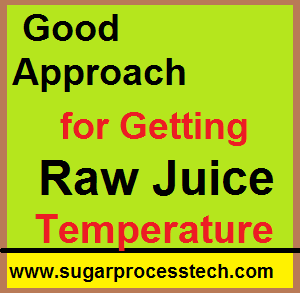Good Approach for Getting Raw Juice Temperature In the View of Energy Saving Concept
Raw juice temperature raised upto 70 to 75oC is the 1st step in Sugar processing. For obtaining this temperature follows two to three stages heating with different types of heaters like tubular heater, direct contact heaters and plate type heater by using different heating media. In this article discussed best approach for raw juice heating.
Use of vapour line juice heater for raw juice 1st stage heating with lost evaporator body vapour
a) In the concept of waste heat recovery, from vapour line juice heater is the one of the most impartent equipment. Here raw juice can heat upto 45 to 55oC .
b) In vapour line juice heater heat transfer coefficient is very high when compare to dead end type juice heater due to its dynamic vapour effect.
c) Provide one valve or damper arrangement with auto control system in-between VLJH and condenser is also benefit to achieve good temperature approach. ( easy perceive for this concept think about – consider 5th body calendria, here provide NCG lines only for vacuum creation means total 4th vapour condensed in 5th calendria and remaining uncondensable gases removed purpose we provide pipe lines )
d) While maintained 5th body temperature by using condenser automation, it will helpful to constant maintaining of syrup brix and getting maximum temperature of raw juice in VLJH. And also helpful to reduce load on condenser.
Raw juice heating by Condensate heater for 2nd stage.
a) The condensate temperature getting upto 80oC after the flash cigar system but our process hot water requirement in-between 60 to 65o. So this excess heat energy used for heating the raw juice 2nd heating.
b) Generally horizontal type juice heaters are used for this heating, here raw juice temperature rise upto 10 to 15oC
c) In the condensate heaters design criteria Duplex type heater design is one of the most efficient type heaters. In the duplex design heat transfer coefficient is very high when compare to normal horizontal type heaters. So in duplex design heating surface requirement is less when compare to other type of tubular heaters.
d) In Duplex heater design flexibility is very high for installing standby heaters and also increasing its capacity. ( i.e with less investment we can provide standby heaters and for existing heater we can easily increasing the heating surface )
Use Tubular heater with dynamic effect on 4th vapour for raw juice final heating.
a) Generally dead end and dynamic type tubular heaters are used in sugar industry. In the dynamic effect the heat transfer coefficient is high when compare to dead end type heater and also getting the temperature approach in dynamic effect upto 5 to 6oC. So that 4th vapour is sufficient for getting raw juice final temperature.
b) When compare Direct Contact heater(DCH) & tubular heater for final raw juice heating with same vapour bleeding, tubular is one of the good option regarding to steam economy because while using DCH getting the extra condensate load on evaporator set.
Some Related Articles:
Juice Defecator and Juice Sulphitor Design Criteria | Online Calculator | Design Calculation of Juice Defecator and Sulphitor with online calculator.
Juice Sulphitation Process | Methods of Sugar Cane Juice Sulphitation | Reactions and methods of sugar cane juice sulphitation process.
Sulphur Melter | Sulphur Melting process in sugar processing industry
Flash Vapour Calculation | Flash Vapour Recovery Vessel Design Calculation. Condensate flash vapour recovery system calculation with example.
Heat Transfer Coefficient of Liquid -Liquid Tubular Heater Calculation| HTC | How to find Condensate Juice Heater Heat Transfer Coefficient Calculation.
Hi friends Thanks for reading. I Hope you liked it. Give feed back, comments and please don’t forget to share it

10 thoughts on “Best steam economy option for Raw Juice Heating in sugar industry”
Subodh Rana
(August 3, 2017 - 4:37 am)Dear Shiva Sir,
Please describe, how to calculate the heat transfer coefficient for dynamic juice heaters.
siva alluri
(August 7, 2017 - 1:17 pm)Dear rana sir
For dynamic heater HTC purpose having simple formula
Hausbrand had proposed the following equations
U = 750 x cuberoot {(0.007 x Vj)} x sqrt(Vs) in Kcal/hr/m2/oC
Vj = juice velocity in m/sec
Vs = vapour velocity in m/sec
From this formula we get HTC for fresh heater(After cleaning of 1st day)
But in practical we take 50% value from above calculated value
siva alluri
(September 21, 2017 - 1:27 pm)Heat transfer coefficient calculation of liquid liquid tubular heater | Condensate
juice heater heat transfer coefficient calculation in sugar industry.
https://www.sugarprocesstech.com/heat-transfer-coefficient/
Neeraj kumar
(October 3, 2017 - 5:23 pm)Sir I want to know the heattransfer coefficient of vapour line juice heater
siva alluri
(October 4, 2017 - 5:36 pm)Ok sir This calculation will be publish as possible as
Neeraj kumar rajput
(October 4, 2017 - 6:13 pm)What is the role of ligament of design of heater
Amar saini
(August 15, 2021 - 12:46 pm)Ligament in any heat exchanger relate with the passage of heating media vapor i.e. according to vapour velocity and quantity and duty of heat exhchanger ligament is setup for example near the vapour entry ligament small and wider area of calandria it is greater.
Amar saini
(August 15, 2021 - 12:37 pm)Hay namasta
Yogesh Mani Tripathi
(September 21, 2022 - 4:31 pm)Sir, small doubt is there if we installed a valve between VLJH and condenser then it’s work like dead end type juice heater Or dynamic juice heater.
siva alluri
(October 1, 2022 - 3:31 pm)Providing valve is gives better result. But completely closing of the valve is not possible. Because we must send the NCG to condenser